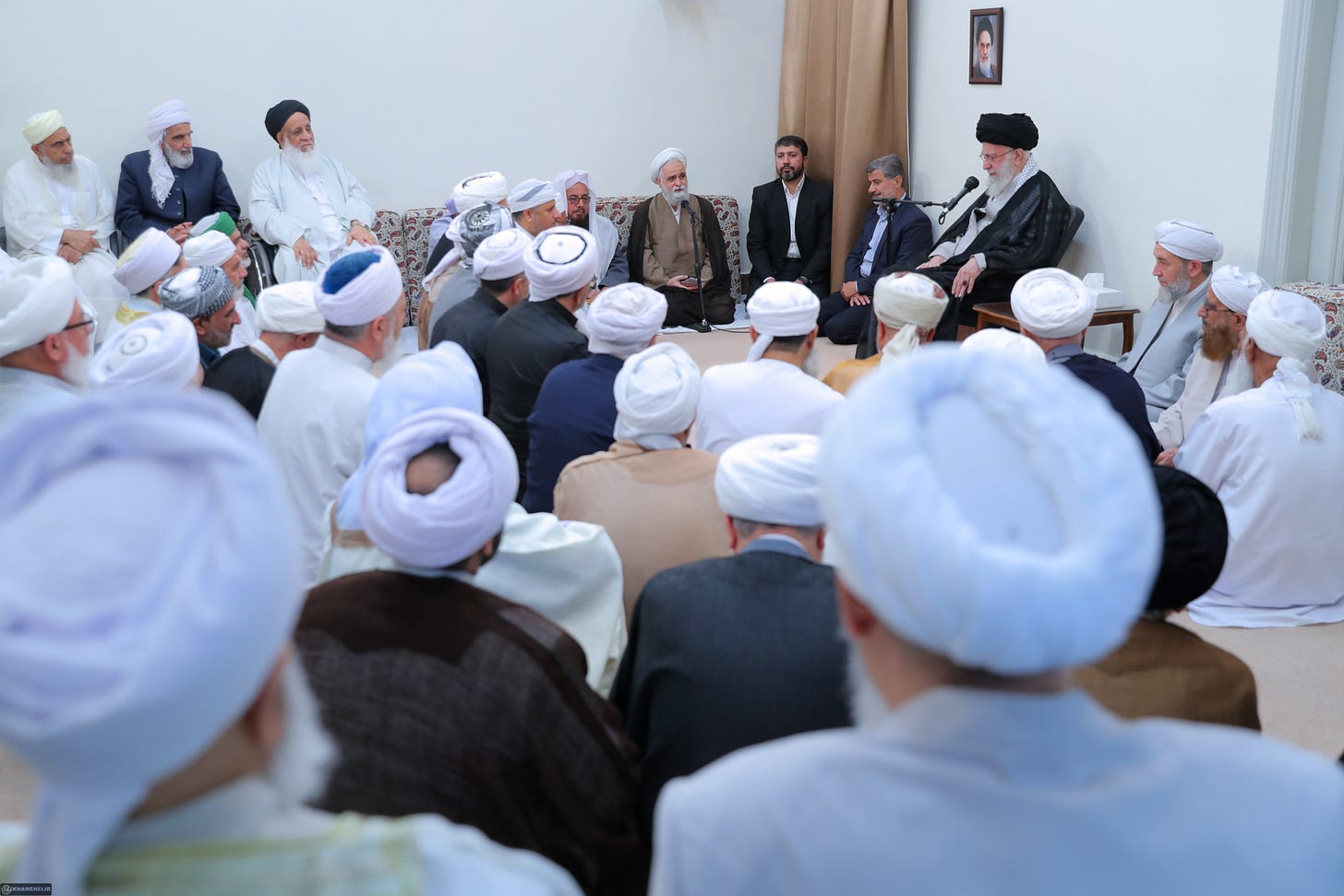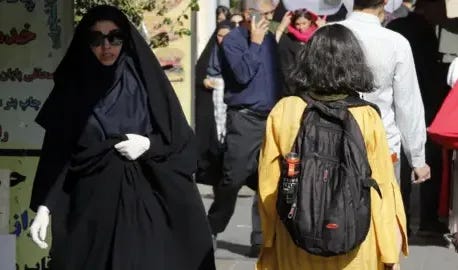India Rejects Iran's Remarks on Indian Muslims, Calls Out its Repression of Women
The Proposed "Hijab and Chastity Bill" is Set to Enact Draconian Provisions Despite Earlier Assurances from Iran's New President.

India Rejects Iran's Remarks on Indian Muslims
India has forcefully rejected the latest remarks made by Iran's Supreme Leader, Ayatollah Ali Khamenei, concerning the treatment of Indian Muslims, calling them "unacceptable" and "misinformed." On the birth anniversary of Prophet Mohammed (PBUH), Khamenei took to X (formerly Twitter) to compare the situation of Indian Muslims with those suffering in Gaza and Myanmar, implying widespread oppression. New Delhi, in a sharp response, advised Tehran to introspect on its own treatment of minorities before commenting on others.
India's statement reaffirms its commitment to religious diversity and secularism, dismissing the remarks as politically motivated distractions1. Furthermore, India subtly pointed out the irony of such criticism coming from a regime that systematically oppresses nearly 50% of its own population — Iranian women — through draconian laws, mandatory dress codes, and severe restrictions on personal freedoms. Iran's repressive policies toward women stand in stark contrast to India's democratic values and unwavering dedication to equality for all its citizens.

Iranian Women’s Fight for Freedom
Iran’s Hijab and Chastity Bill: Intensified Surveillance and Repression
The proposed "Hijab and Chastity" Bill in Iran has reignited the protests that first exploded two years ago following the death of 22-year-old Kurdish woman Mahsa Amini. In the wake of her tragic death, Iran has seen a dramatic intensification of state surveillance and repression, with women bearing the brunt of the crackdown. The 2022 protests, which erupted under the powerful slogan "Woman, Life, Freedom," were met with an uncompromising response from Iran’s conservative regime. Leveraging increasingly sophisticated tools, the government has expanded its efforts to monitor and suppress dissent. Women have been placed under intense scrutiny, with their online activities meticulously tracked, leading to widespread arrests, intimidation, and harsh punishments for defying the state's rigid dress codes or participating in protests.
Iran's Proposed Hijab and Chastity Bill: Escalating Repression
The proposed Hijab and Chastity Bill introduces a series of harsh penalties for those who violate hijab laws, intensifying the government's grip on personal freedoms. The bill mandates increased prison terms of up to 10 years for opposing hijab regulations, alongside heavy fines, floggings, and restrictions on travel and employment. Additional measures include the use of surveillance cameras and facial recognition technology to identify non-compliant women. Offenders could even face mandatory psychological treatment. Passed by the Iranian parliament in September 2023, the bill still requires final approval from the Guardian Council. It has been widely condemned by human rights organizations as a severe assault on women’s rights and freedom of expression in Iran.

Online Monitoring and Technological Tools in Iran
The Iranian government’s use of technology for control has become more pervasive, with apps like Nazer enabling citizens to report women not adhering to the mandatory hijab laws. The nationalisation of parts of the internet has also allowed the government to offer cheaper web access in exchange for personal data, making it easier to track and identify dissenters. These measures have led to widespread arrests, public lashings, and severe punishment for resisting state-imposed regulations.
Consequences for Women: Arrests, Punishments, and Physical Violence
Women who resist the state’s mandatory dress codes face harsh consequences, including arrests and charges such as “promoting corruption” or “propaganda against the state.” Many women have received public lashings, suspended sentences, and long-term punishments. Reports from international organizations, including the UN, reveal troubling patterns of physical violence, with security forces regularly using beatings and other forms of abuse against women deemed non-compliant with hijab laws.
Recent Developments in Iran: A Contradictory Government Stance
Despite promises of reform from Iran’s newly elected president, Masoud Pezeshkian, who claimed that the morality police would no longer "disturb" women over the compulsory hijab, the government's actions tell a different story. The ongoing repression and the impending "Hijab and Chastity" Bill show a stark contrast between official rhetoric and the realities on the ground, further intensifying the penalties for women who defy the dress code.
International Response: UN and Human Rights Organizations’ Involvement
The global response to Iran’s crackdown has been one of concern. The UN Human Rights Council has extended the mandate of its Fact-Finding Mission on Iran, while organizations like Amnesty International and Human Rights Watch continue to document the government's escalating human rights violations. These international bodies are calling for accountability as Iran’s regime intensifies its efforts to stifle dissent, particularly against women.
Malala Yousafzai’s Stand on Iran’s Hijab Protests: A Fight for Choice and Freedom
Nobel Peace Prize laureate Malala Yousafzai has voiced her support for Iranian women, highlighting that the hijab protests are not just about the headscarf but about the fundamental right to choose. Quoting an Iranian woman, Malala said, "People said it was about hijab, but really it's about choice. I want to be able to choose what I wear, what music I listen to..." She expressed deep concern about the "unbearable" conditions faced by women in Iran and praised their courage, noting that the protests are already changing the world. Malala’s advocacy aligns with her global mission to support women’s autonomy and empowerment.
The Background: Mahsa Amini’s Death and Its Fallout
Mahsa Amini’s death, following her arrest for allegedly breaching Iran’s strict hijab laws, exposed the harsh realities of Iran’s morality policing. Her death unleashed a wave of protests, with women at the forefront, demanding an end to state-enforced oppression. The compulsory hijab, once a religious symbol, has become a representation of state control over women’s bodies and choices. The movement that arose from Amini’s death has expanded into a larger fight for basic human rights, gender equality, and an end to theocratic rule.

Iran's Past: The Fall of the Shah and the Rise of the Islamic Regime
To understand the significance of the current protests, it is essential to look back at Iran's history, particularly the fall of the Shah in 1979 and the rise of Ayatollah Khomeini’s Islamic Republic. Under the Shah, women enjoyed relative freedom in dress and public life, with reforms aimed at modernising Iran. However, the Islamic Revolution reversed many of these rights, enforcing mandatory hijab laws and reducing women’s freedoms in areas like marriage and divorce. The regime's focus on controlling women’s bodies became a central tool of its governance.
Women’s Rights Across the World: Lessons from Saudi Arabia
Even as Iran intensifies its crackdown, Saudi Arabia—once known for its rigid conservatism—has made significant strides in women’s rights under Crown Prince Mohammed bin Salman’s Vision 2030. Saudi women, once barred from driving or travelling without male guardians, now enjoy unprecedented freedoms, including the right to drive and participate in public life. These reforms demonstrate that even the most conservative societies can evolve, underscoring the importance of empowering women. Saudi Arabia’s progress stands in stark contrast to Iran’s continued repression, highlighting the broader global conversation on women’s autonomy.
India's Commitment to Minority Rights: A Constitutional Guarantee
India strongly condemns the remarks made by Iran’s Supreme Leader regarding the treatment of Muslims in India. Such comments are unfounded, especially when India’s Constitution provides special protections for religious and linguistic minorities under its Fundamental Rights—safeguards, rather privileges, that even the majority community does not enjoy. These rights embody India’s commitment to secularism, inclusivity, and respect for diversity, ensuring equal opportunity and protection for all its citizens, regardless of faith.
Iran's Repression vs. Global Human Rights Norms
In stark contrast, Iran—now lecturing us on minority rights—continues to unleash systemic repression on its own population, particularly targeting women. Through draconian laws, forced dress codes, and severe restrictions on personal freedoms, Iran stands far removed from internationally accepted standards of human rights, including those embraced by many Islamic nations. Instead of casting unwarranted criticisms on other countries, Iran should focus on addressing the legitimate aspirations of its own people and aligning its policies with global norms that respect freedom and dignity for all.
Citations
[1] Mahsa Amini Protests
[2] The 1979 Iranian Revolution
[3] Karnataka Hijab Controversy
[4] Saudi Arabia at Forefront of Women Rights
Citations (Malala)
[1] Malala's Twitter Comment on Choice
[2] New York Times: Nobel Peace Prize
[3] Arab News on Malala’s Comments
[4] Arab News on Iran and Women’s Protests
[5] VOA News: Malala on Women’s Rights
[6] Women in the World Forum
[7] Dawn News on Malala’s Advocacy
"The comments made regarding minorities in India by the Supreme Leader of Iran are strongly deplored," the foreign ministry stated in an official response.
"These remarks are both misinformed and unacceptable. Nations offering commentary on minority issues are advised to first reflect on their own track record before passing judgments on others," New Delhi added.



